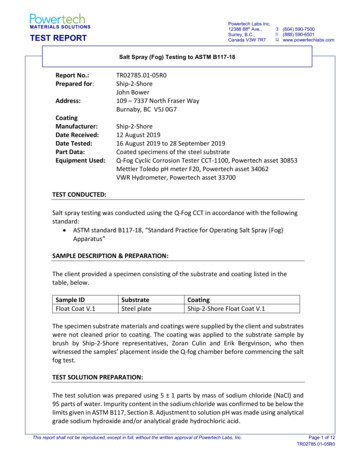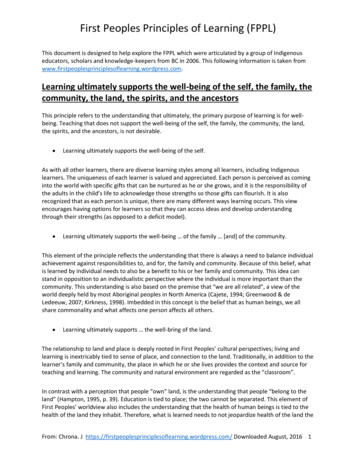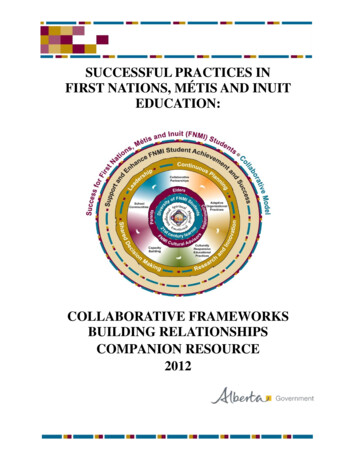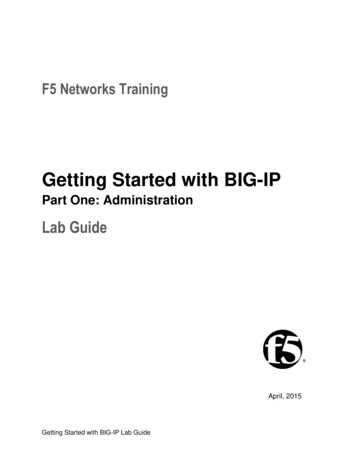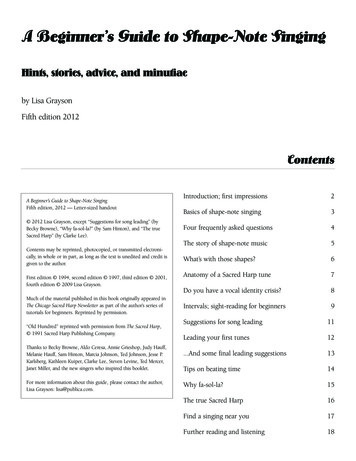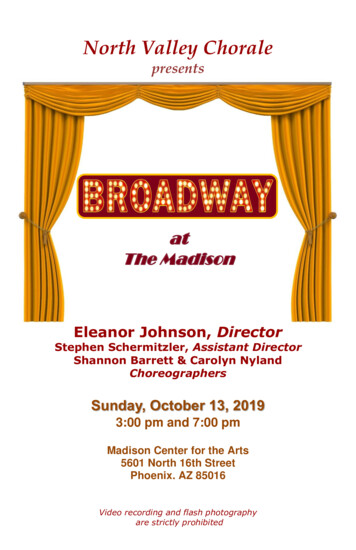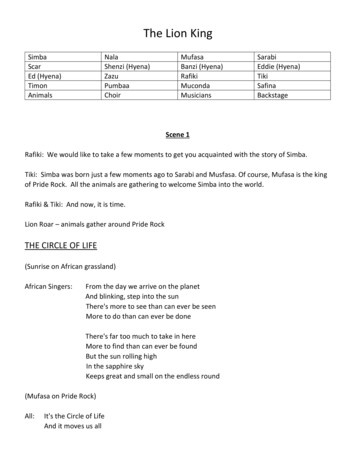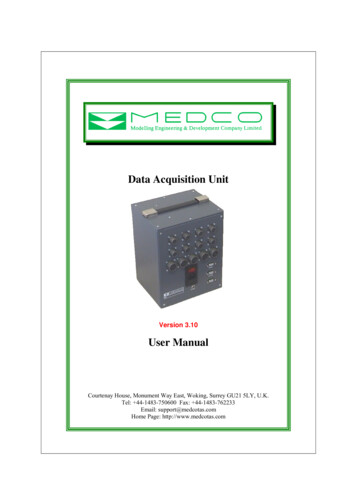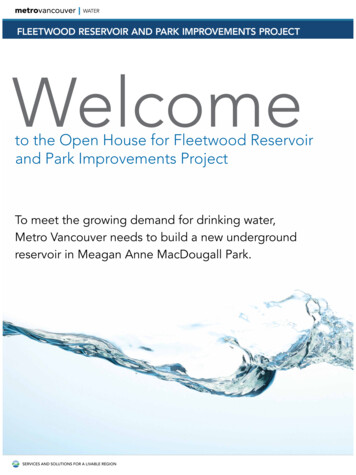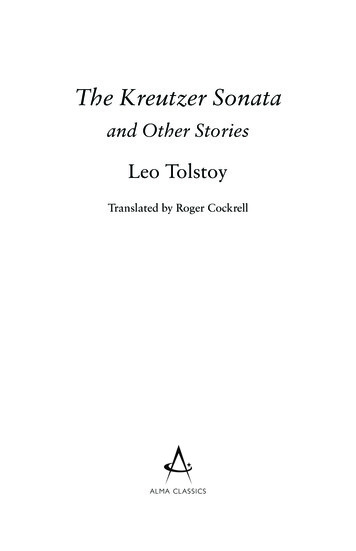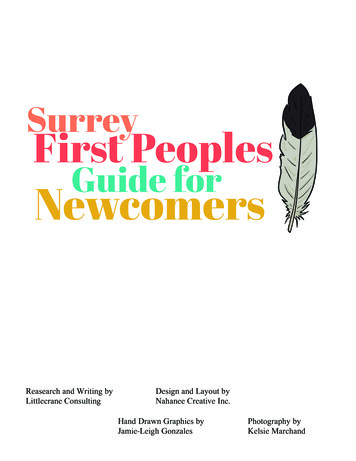
Transcription
SurreyFirst PeoplesGuide forNewcomersReasearch and Writing byLittlecrane ConsultingDesign and Layout byNahanee Creative Inc.Hand Drawn Graphics byJamie-Leigh GonzalesPhotography byKelsie Marchand
Table of ContentsTerritorial Acknowledgement 3Forward 3Welcome 4Definitions 5Stories from Land-Based Nations 8Chief Harley Chappell of Semiahmoo First NationChief Marilyn Gabriel of Kwantlen First NationProtocols 10Starting in a Good WayThe Importance of the Territorial AcknowledgmentHolding our Hands UpHistory of Land-Based Nations 12Contact 13Semiahmoo at the time of contactBordersClash of Indigenous & Western WorldviewsSurrey Urban Indigenous and Métis Community 15Indigenous Communities in SurreyMétis Community in SurreyIndigenous Rights & Title: Canadian Policy 17Papal BullsTerra NulliusRoyal Proclamation of 1763DiseaseIndian ActIndian Act TodayReserves & HousingIndigenous Women & the Indian ActThe Indian Residential School SystemReturning homeCurrent policies Impacting Indigenous peopleAnti-Indigenous Racism in Canada 25Where do Myths Come from?Myths & MisconceptionsMyth or FactIndigenous Resurgence 28Indigenous Brilliance 29Celebrating Indigenous Role Models in Surrey2
TerritorialAcknowledgementThis work is taking place on the ancestral, traditional andunceded territories of the SEMYOME (Semiahmoo), q̓ic̓əy̓(Katzie), kʷikʷəƛ̓əm (Kwikwetlem), q̓ʷɑ:n̓ƛ̓ən̓ (Kwantlen),qiqéyt (Qayqayt), xʷməθkʷəy̓əm (Musqueam) and sc̓əwaθənməsteyəxʷ (Tsawwassen) First Nations. The knowledge,traditions and ongoing contributions of these communitiesare significant in providing context to the work of thisresource. We pay our respects to their Elders past, present andemerging.these communities were going through incredible challenges.Our hands go up to the tireless efforts of the land-basedNations to assert their rights, not only for themselves but ina way that impacts all Indigenous people in the region. Thisleadership shows us the spirit of the land-based laws, systemsof accountability and important teachings that have existedhere since time immemorial.The Surrey First Peoples Guide would like to thank ChiefHarley Chappell of Semiahmoo First Nation and ChiefMarilyn Gabriel of Kwantlen First Nation for providing theirwisdom, truth, and sharing their heartfelt intentions for theircommunities. These interviews were conducted at a time whenForwardIt is worth mentioning that as Indigenous peoples of TurtleIsland (North America), we have been left out of the historybooks, guidebooks, and education programs for well overone hundred years in Canada and the US. There has been along and treacherous history of erasing us from society. Theimportance of documents like this First Peoples Guide, writtenby Indigenous people and within an Indigenous perspective isa celebration, a progressive step in the right direction towardslearning, understanding and respecting the original and FirstPeoples of the lands you now call home.Len Pierre, Katzie First Nationə́y̓ swéyəl (good day) & mí ce:p kʷətxʷíləm (welcome). Myname is Len Pierre, my ancestral name is Puleeqweeluck,I am Coast Salish from Katzie First Nation, one of the hostterritories of the municipality of Surrey. To you I say haycxʷ q̓ə (thank you). Thank you for being here, for picking upthis guide, reading it, internalizing it, leaning in with yourcuriosity, with a sense of unity, and a sense of humility.Thank you for being here, your presence and participation inthe learning, understanding and relationship building of FirstPeoples cannot be understated.Upon reading and learning this document, I encourage eachand everyone of you to set an intention to keep an open heartand open mind with what you are about to learn. Not just inreading this guide, but to continue to hold that space in yourheart and mind long after you read this. We, the First People,have been on this land since the beginning of time. We have anancient knowledge and wisdom of the land, water, and air weall enjoy so much.On behalf of the people, Nations, and lands you call home,welcome to each and everyone of you! Be well, continueyour learning about the land and the First People, and alwaysremember to treat one another with compassion. Those are thelaws of the land here.-Len Pierre, Katzie First Nation3
WelcomeThe Surrey First Peoples Guide for Newcomers is a responseto the call for accurate resources on First Peoples in Canadafrom an Indigenous perspective. In 2018, the Indigenous andNewcomer Youth Dialogues Project brought young peoplefrom both communities together to Kwantlen First Nationto learn about their respective lived experiences and to buildsolidarity. Through these dialogues, newcomer youth reportedthat misconceptions about Indigenous people are normalized(acquired) immediately upon arriving in Canada. This indicatesthat discrimination against Indigenous people is a norm inCanada and needs to be proactively addressed.In this resource, we will provide information on the traditionalprotocols, histories, and current realities of Indigenous,Metis, and Inuit people in Canada, and address commonmisconceptions about the First People of this land. Byadopting a community-centred approach, this document seeksto uplift and amplify the voices of the land-based Nationsthat Surrey occupies. This resource will uncover hard truths,constuct a foundation for shared understanding, and continuethe important work of building solidarity between theIndigenous and newcomer communities in Surrey.In 2014, the City of Vancouver released the First PeoplesGuide for Newcomers. This extensive report offered clearinformation about Indigenous, Métis and Inuit people inCanada. The author, Kory Wilson, is now the ExecutiveDirector of Indigenous Initiatives and Partnerships at theBritish Columbia Institute of Technology (BCIT). Kory hascreated a free, interactive, online course called the IndigenousAwareness Modules. This report will reference Kory’s workto ensure that we are not doubling our efforts and that we arecreating space to uplift the voices of local, land-based leadersand community members. The authors hold our hands up toKory in respect of the years of dedicated work she has done tocreate quality resources about Indigenous people. We hope tohonour the writers, knowledge keepers and Elders who havedone this work before us in a good way.To access BCIT’s free, interactive Indigenous AwarenessModules: indigenous-modules/To access Kory Wilson’s Pulling Together Foundations ons/This resource will refer to the extensive research conductedover the last five years by the Surrey Urban IndigenousLeadership Committee (SUILC). The committee is a coalitionof local Indigenous and non-Indigenous organizations thathave a significant connection to the Indigenous population4in Surrey. SUILC’s research and initiatives have providedimportant findings on the Indigenous community in Surrey.This work uplifts local, Indigenous and Métis wisdom,which advocates for the community’s needs. SUILC outlinesfour priorities in their report to the Province of BC: 1Reducing urban Indigenous child poverty; 2 Creating moreIndigenous housing options; 3 Establishing the infrastructurefor community and cultural resurgence; 4 Addressing antiIndigenous racism.The Surrey First Peoples Guide will use a community-centredmethod that uplifts the stories of the land-based Nations, urbanpopulations, and Indigenous champions. Anti-Indigenousracism is a common experience for Indigenous people living inSurrey. Racism and stereotypes negatively affect Indigenouspeople in many areas of life , including health, justice,education, and social services. When these racial stereotypesare normalized, Indigenous people face greater barriers intheir communities. Actively dismantling these stereotypes andnormalized biases will work to ensure that Indigenous, Metis,and Inuit people in Surrey live free from colonial harm.
DefinitionsAboriginal (n):Coast Salish (n.):Aboriginal: Section 35(2) of the Constitution Act, 1982defines Aboriginal peoples to include: Indian, Inuit, Métis.Both Indigenous and Aboriginal are collective nouns for FirstNations, Inuit, and Métis. It is important to note that there areoften regional and personal preferences for terms.“Coast Salish is the term used for the group of ethnicallyand linguistically related Indigenous peoples of the PacificNorthwest, living in BC and the northwestern United States.Coast Salish territory straddles the Canada-US border fromthe northern part of the Gulf of Georgia to Oregon, and coversthe lower half and eastern side of Vancouver Island, all theLower Mainland and most of Puget Sound and the OlympicPeninsula.Aboriginal rights and title (n.):“are collective rights that flow from the simple fact thatsince time immemorial Indigenous people have continuouslyoccupied this land that is now called Canada. Indigenous rightsare different from rights that non-Indigenous Canadians haveand they cannot be extinguished, legislate away or “writtenoff.”Canadian law recognizes and protects Aboriginal Rights andTitle in s. 35 of the Constitution Act, 1982. Section 35 is asfollows:35. (1) The existing aboriginal and treaty rights of aboriginalpeoples of Canada are hereby recognized and affirmed.”“Aboriginal Title is the inherent Indigenous right to land. Itis Aboriginal Title to land whereas Aboriginal Rights are therights to use and occupy the land. They are both protectedunder s.35 of the Constitution Act, 1982. Since 1982, themeaning and extent of Aboriginal Title and Rights has been thesubject of much Indigenous litigation in Canada.”Contact or First Contact (n.): Before the arrival of thecolonizers, Indigenous people were organized into complex,self-governing nations throughout what is now called NorthAmerica. The conception of “contact” or “discovery” isinvalid, as Indigenous people existed on Turtle Island forthousands of years.Assimilate (v.), assimilation (n.):“encouraging them or coercing them to abandon their culture,languages, and way of life, and to adopt the culture of thecolonizers.”In 2010 the bodies of water previously known as the Strait ofGeorgia, Gulf of Georgia, Strait of Juan de Fuca and PugetSound were officially renamed the Salish Sea in honour of theFirst Peoples who live on their shores.”Colonize (v.), Colonization (n.):“Colonization is a process where one group of people movesinto the territory or area of another group then ultimately takesover and changes the lives of the colonized. Colonization hashappened all over the world: the British and French in NorthAmerica; the British in India; the Dutch in South Africa;the Spanish in Latin America; and the Portuguese in Brazil.Today many Indigenous groups are living with the impacts ofcolonization and they are fighting for self-determination.”“Colonization occurs when a new group exercises control overa Indigenous group. The colonizers impose their own culturalvalues, religions and laws, and make policies that are in theirfavour, and against the Indigenous peoples. They seize landand control the access to resources and trade. As a result, theIndigenous people become dependent on the colonizers.”Culture (n.):“An expression of a community’s worldview and uniquerelationship with the land. Indigenous cultures across Canadaare diverse, but there are commonalities amongst them.Traditionally, their societies were communal: every memberhad a role and responsibilities, there was equality between menand women, nature was valued, and life was cyclical”5
Enfranchisement (n.):Indian (n.; adj.), Indian status (n.):Enfranchisement is a legal process to terminate a person’sIndigenous status and status rights and to confer full Canadiancitizenship. This process was initially voluntary underthe Gradual Civilization Act of 1857 and became legallycompulsory under the Indian Act of 1876, which was in placeuntil 1961. The aim of enfranchisement was the assimilationof ‘civilized’ individuals and Bands into settler society andmeant that Indigenous men could own property (subtractedfrom allotted reserve lands) and vote in Provincial and Federalelections (Indigenous women were not given any legal rightsat the time). Enfranchisement continued until 1985, in caseswhere, when an Indigenous woman married a non-Indigenousperson, she would lose her status.No, it is not okay to use the word “Indian”. The use of theterm “Indian” in Canada is considered outdated and offensive.With enfranchisement, status holders would lose their status ifthey: Served in the Canadian Armed ForcesEarned a college or university degreeLeft their reserves for long periods, e.g. for employmentBecame an ordained ministerBecame a professional, e.g. a doctor or lawyerElder (n.):“In Indigenous cultures, Elders are cherished and respected.An Elder is not simply an older or elderly person, but rather,they are usually someone who is very knowledgeable about thehistory, values and teachings of his or her culture. He or shelives their life according to these values and teachings.For their knowledge, wisdom and behaviour, Elders arevaluable role models and teachers to all members of thecommunity. Elders play an important role in maintaining thetradition of passing along oral histories.”First Nation (n.):“In Canada, First Nations is the term used to refer to peoplewho are Indigenous and who do not identify as Inuit or Métis.In the past, First Nations people used to be referred to as“Indians”. There are 634 First Nations across Canada and over60 distinct Nations.First Nations is the accepted term today instead of the term“Indian” which is considered an offensive colonial term.”Indigenous (n, adj.):“Indigenous is a term that is being heard more and morein Canada. It is being used synonymously with Aboriginal,and is the preferred term. Both Indigenous and Aboriginalare collective nouns for First Nations, Inuit, and Métis. It isimportant to note that there are often regional and personalpreferences for terms.”6However, the term is still in use in legal documents such asthe Indian Act and in the Constitution Act (1982). The term“Indian” is used when referring to a First Nations person withstatus under the Indian Act. The Indian Act defines who isand who is not an Indian. Those with status have cards that“Certify their Indian Status”.Indian Act (n.):The Indian Act was another attempt to assimilate First Nationspeople into European society as quickly as possible. Undersection 91(24) of the British North America Act (1867), theFederal government was given jurisdiction or control over“Indians and Lands reserved for Indians”.Inuit (n.; adj.):“The Inuit are a group of Indigenous peoples living in theNorthern regions of Canada, Greenland and Alaska. Inuithave lived and thrived in the Arctic for thousands of years.Traditionally, they lived off the resources of the land byhunting whales, seals, caribou, fish and birds. Many Inuitcontinue to harvest these resources today.”*Historically Inuit were referred to as “Eskimos”, but thisterm is neither accurate nor respectful, and should not beused.”Land claim (n.):“The Government of Canada officially calls modern treatiesComprehensive Land Claims.”Oral Tradition (n.):“Indigenous peoples pass along values and histories throughoral storytelling. Oral histories and stories have been passeddown from generation to generation and are essential tomaintaining Indigenous identity and culture. People repeattheir history and stories to keep information alive overgenerations. Often it is the role of particular people within eachcommunity to memorize the oral history with great care. Thesepeople are often called Witnesses.”
Reserve (n.):“Land that has been set apart by the Federal government forthe use and benefit of an Indian band.”Not all Indigenous people live on reserves. In 2011, thestatistics were as follows for the First Nations people whoreported being Registered Indians: 49.3% (637,660) lived on a reserve in CanadaIn Quebec, 72% lived on reserve, the highest proportionamong the provincesIn New Brunswick, 68.8% lived on reserveIn Nova Scotia, 68% lived on reserveIn Ontario, 37.0% lived on a reserveIn Newfoundland and Labrador 35.1% lived on reserve”Many First Nations people would like to live on their reservesbut there are many reasons why they cannot – often there arenot enough houses, the reserves are too far away from theiremployment, or the infrastructure is insufficient.Self- Determination (n.):The United Nations Declaration on Rights of IndigenousPeoples includes the right to self-determination. The Assemblyof First Nations describes self-determination as a Nation’s rightto choose its own government and decide its own economic,social and cultural development. Today, Indigenous people areexercising Aboriginal Rights and Title for self-determinationand benefitting from the wealth and resources of this land thatis now called Canada”Settler-colonialism (n.):First, settler colonizers “come to stay”: unlike colonial agentssuch as traders, soldiers, or governors, settler collectivesintend to permanently occupy and assert sovereignty overIndigenous lands.Second, settler colonial invasion is a structure, not an event:settler colonialism persists in the ongoing elimination ofIndigenous populations, and the assertion of state sovereigntyand juridical control over their lands. In 2009 Stephen Harpersaid “Canada does not have a history with colonialism.” Thisstatement was widely criticized because 1) the Canadiangovernment had issued the apology for the Residential SchoolSystem in 2008 2) colonialism in Canada is still alive andwell. Indigenous people still feel the impacts of unjust laws inplace today. Despite notions of post-coloniality, settler colonialsocieties do not stop being colonial when political allegiance isobtained.Third, settler colonialism seeks its own end: unlike othertypes of colonialism in which the goal is to maintain colonialstructures and imbalances in power between coloniser andcolonised, settler colonisation trends towards ending colonialdifference in the form of a supreme and unchallenged settlerstate and people. However, this is not a drive to decolonise,but rather an attempt to eliminate the challenges posed tosettler sovereignty by indigenous peoples’ claims to land, byeliminating indigenous peoples themselves and asserting falsenarratives and structures of settler belonging.Status and Non-Status Indians (n.):A “Status Indian” (or “Registered Indian”) is a personrecognized by the federal government as being entitled to beregistered under the Indian Act, as an “Indian”.“Non-status Indians” refers to people who identify as FirstNations (Indians) but who are not entitled to registration onthe Indian Register pursuant to the Indian Act. Some may alsohave membership in a First Nation.Sovereignty (n.):“Historically, First Nations managed their lands and resourceswith their own governments, laws, policies, and practices.Their societies were very complex and included systemsfor trade and commerce, building relationships, managingresources, and spirituality.”Treaties (n.):Early settlers “viewed treaties as a process transferring titleand control of Indigenous land to non-Indigenous people andgovernments.”“In signing treaties with First Nations, the British government,followed by the Canadian government (after 1867), viewedtreaties as the completion of transfer of title to the Crown.”“First Nations viewed themselves as equal partners (a Nation)when signing treaties and believed that under the treaties theywould still have access to their way of life and their traditionalterritories.”Terra Nullius (n.):“European map-makers drew unexplored landscapes as blankspaces instead of interpreting these blank spaces as areas yet tobe mapped, they saw them as empty land waiting to be settled.When Europeans arrived in North America, they regarded itas terra nullius or “nobody’s land”. They simply ignored thefact that Indigenous people had been living in these lands forthousands of years, with their own cultures and civilizations.For the newcomers, the land was theirs to colonize. As timepassed, the newcomers began to take over land that was partof the traditional territories of Indigenous people who hadoccupied this land long before the arrival of the newcomers.”Traditional territory (n.):Land that a First Nation has lived on or used since timeimmemorial. They have a primary sacred, cultural andeconomic connection to this land. [T]the geographic areaidentified by a First Nations as the area of land which they and/or their ancestors traditionally occupied and used. Often partsof these territories were shared with neighbouring nations.”7
Storiesfrom the Land-Based NationsChief Harley Chappell of Semiahmoo First NationGood day. My Traditional name is Xopocton and myEnglish name is Harley Chappell. I am the elected leader ofSemiahmoo First Nation (one of the traditional territoriesSurrey resides on). When we talk about Semiahmoo precontact, we need to put that into context. When we talk aboutour story of the flood, it is not our origin story, as that predatesour flood story. We describe ourselves as the “Xlactumushpeople’’ which translates to “survivors of the great flood”I’ll begin by addressing the English term, story. When wesay “story,” there’s a misbelief or misunderstanding that ourstories are fictional. But we call them Xol Xol (oral tradition).We call Xol Xol our ancient history that has been passed downgeneration to generation through oral tradition.These are not stories. When Semiahmoo people go back inour history, we go back pre-flood times, go a little bit furtherbefore that. We even have oral tradition, oral history aboutwhen the world was different. This was a time when humansand animals and nature were much more interconnected.I was once working with a group and someone said to me “youknow, you seem like a pretty smart guy, how can you believethat?” My explanation is this: I asked this person, “Do youlove your grandparents?” And they said, “Yes, of course!” Isaid, “Do you think your grandparents would lie to you andsend you on a wrong path?” They said, “Absolutely not.”I agreed with him. “I don’t believe that, that our ancestorswould have lined us up with, with lies, or with falsehoods”Our oral traditions have held our history, held our customs,our practices, and our protocols, through ceremony andthrough our relationship with our lands, our territories, and itholds our connection to those ancient times. And I share thatbecause as a younger leader, I say that we have to have thatfaith, we have to have faith in our history, to acknowledge, andunderstand it. It’s that simple phrase, “You don’t know whereyou’re going if you don’t know where you’ve been.”So, when we talk about our origin and our relationship tonature and our relationship to the animals, and the sea life,then we begin to understand even the root word of who we8are, as “Semiahmoo” people. Semiahmoo means the “place ofthe people.” We are also Xwelmux (people of the land). So,when we say Semiahmoo and Xwelmux - we understand whowe are and where we come from.As Indigenous people, we need to understand this fundamentalbelief system. We need to take a few steps back andacknowledge the differences between western and Indigenousworldviews. Our main challenge right now is arounddifferences in western and Indigenous worldview when itcomes to the protection and safety of our earth, waterwaysand lands, the consumption of resources and land and why andhow we do that.“You don’t knowwhere you’regoing if you don’tknow whereyou’ve been
Xopocton, Chief Harley ChappellChief Marilyn GabrielChief Marilyn Gabriel of Kwantlen First NationOn Kwantlen territory, there were 10,000 people. Aftersmallpox and other devastations Kwantlen’s population wasreduced to 69 people. Now in Kwantlen, there are 310 people.We are trying to reinstate more. One of the Elders is fightingfor our people to get their status back and for them to comehome. It’s not our people’s fault they can’t live at home. Wetry to welcome everyone home with open arms, an open mind,and an open heart. My late father appointed me to Chief onJune 11, 1993, my daughter Tricia’s birthday. They had a biggathering on our sports field. They were bestowing the titleof Grand Chief on my father, Grand Chief Joe Gabriel. Theywere having a big gathering and my father was not well. Hehadn’t been well for some time. But he said, “You come downwith me, but YOU will have work to do as well.” Back inthe day, and even today it is really hard being a leader in thecommunity. It’s just not a nice thing sometimes.I was pushing my father down the hill to the field in hiswheelchair. Just before we were to go out to the field, my Dadtold me “it’s going to be you.” [I was going to be chief.]I was like “What?!”Back in the day, the word “chief ” or “leader” was not a niceword. It was almost like a swear word. We didn’t feel proudof who we were. Nobody wanted to be chief, and we sort ofpassed it around like a hot potato!I am the middle child of 9 children. As I was pushing himdown the hill, I said “Dad, you know you don’t have to do this!You can give it to my siblings.” He said, “Be quiet and pushme down to the park, I chose YOU! And now let’s be quiet andnow let’s go do our work.”I remember feeling grateful at the gathering. This ceremonywas to honour my late father and uncle because they did over30 years of service for the Nation. They did this work at atime when there was no funding, no money anywhere. Mylate father was a commercial fisherman. Him and my momused most of their money to run our Nation. At that time,they didn’t get paid for anything, it was just their duty to theirpeople.At Christmas time, [the community] would say, “If it wasn’tfor your dad, we wouldn’t still be here [on Kwantlen].” AtChristmas, my family would slaughter some of their cattle andgive them out to community members. We also had to buyfreezers for families because at that time the people didn’t havea way to store food for the winter.My father led with kindness and generosity. I learned fromwatching him that I wanted to keep these values in myleadership of Kwantlen. Leadership based on generosity,respect, and on honouring our culture.”9
ProtocolsProtocols are part of complex Indigenous law systems.Traditional laws and protocols differ from nation to nation.Protocols refer to how land-based Nations conduct ceremonies,welcome guests, honour their ancestors and respect the landsof Nations they visit. Although diverse, these law systems predate contact by thousands of years. Protocols are actions thatensure respectful relationships between different Nations. Forinstance, when a neighbouring tribe would visit Semiahmoothey would back their canoes into shore. This was a sign thatthey were approaching the Nation’s village with respect andsometimes with the spirit of celebration. Songs would be sungto welcome the guests to shore (Chappell, 2021). Today, oneprotocol that is commonly observed is offering a territorialacknowledgement.The Indian Act was a tool to assimilate Indigenouscommunities into Canada. During colonization, protocols andIndigenous law systems embedded in cultural practices wereoutlawed by the Indian Act from 1884 to 1951. Indigenouspeople were often arrested if they were caught practising theirtraditional protocols. The effects from this prohibition havehad long-standing impacts on how protocols and cultural actshave been passed down. Today, practising protocols, suchas territorial acknowledgements, play a vital role in culturalreclamation.Chief Harley Chappell of Semiahmoo describes protocolsused today: “Welcoming other tribes [and] other nations [is]a time when we use our ancestral songs. I was taught thatsong is the first language. So, when we would welcome oneanother when they would visit our community [we wouldsing] and that is something we still practice today. When wedo our canoe journeys, we will sing those songs before wecome to the beach. We'll pull up to the shore, and we'll singthose songs, those welcome songs and those love songs. Andthen we would turn our canoes around and we back them out.Because being here we would understand that if a canoe would[approach] headfirst, it was a sign of war. It was a sign ofconflict. There are very different tones to our welcome songsas opposed to our war songs. And the people would knowby the different songs, how the people are approaching. Butreally, I think it's [acknowledging] we're on somebody else'sland. We don't just come into somebody else's territory and[plop] down and do whatever we want to do. That's really whathappened here in British Columbia. It is a sign of respect andgood practice to acknowledge that we're on these territories,and these are the original people of this land.”Starting in a Good WayKwantlen Cultural Ambassador, Micheal Kelly Gabriel:A few years back, we were doing our First Salmon Ceremony.We do this ceremony to give thanks for the salmon forsustaining our Nations since time immemorial. Over the years,many people have asked for my Grandpa Herb or GrandmaHelen for support with ceremonies and this salmon
cxʷ q̓ə (thank you). Thank you for being here, for picking up this guide, reading it, internalizing it, leaning in with your curiosity, with a sense of unity, and a sense of humility. Thank you for being here, your presence and participation in the learning, understanding and rela
